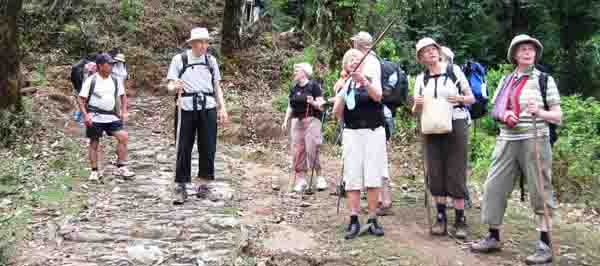
Overview
Mount Everest is the highest mountain in the world. Its elevation of 29,035 feet (8,848 meters) was determined using GPS satellite equipment on May 5, 1999. It was previously believed to be slightly lower (29,028 feet /8,848 meters), as determined in 1954 by averaging measurements from various sites around the mountain. The new elevation has been confirmed by the National Geographic Society.
The first seven attempts on Everest, starting with a reconnaissance in 1921, approached the mountain from Tibet, where a route to the summit via the North Col and North Ridge seemed possible. All were unsuccessful. George Mallory, who spearheaded the first three expeditions, lost his life with Andrew Irvine during a failed ascent in 1924. Unsuccessful attempts continued through 1938, then halted during World War II. By the war's end, Tibet had closed its borders, and Nepal, previously inaccessible, had done the opposite. Starting in 1951, expeditions from Nepal grew closer and closer to the summit, via the Khumbu Icefall, the Western Cwm, over the Geneva Spur to the South Col, and up the Southeast Ridge. In 1953 Edmond Hillary and Tenzing Norgay reached the summit.
Since the first successful ascent, many other individuals have sought to be the first at various other accomplishments on Everest, including many alternative routes on both the north and south sides. Italy's Reinhold Messner has climbed Everest twice without oxygen, once in four days. He is also the first to solo climb Everest, which he did in 1980. Ten years earlier, Yuichiro Miura of Japan had been the first person to descend the mountain on skis. In 1975, Junko Tabei, also of Japan, was the first woman to climb Everest. The first disabled person to attempt Everest was American Tom Whittaker, who climbed with a prosthetic leg to 24,000 feet in 1989, 28,000 feet in 1995, and finally reached the summit in 1998. The record for most ascents belongs to Sherpa Ang Rita, who has reached the summit ten times.
Overall, more than 600 climbers from 20 countries have climbed to the summit by various routes from both north and south. Climbers' ages have ranged from nineteen years to sixty. At least 100 people have perished, most commonly by avalanches, falls in crevasses, cold, or the effects of thin air.
Climbing on Everest is very strictly regulated by both the Nepalese and Chinese governments. Permits cost thousands of U.S. dollars ($50,000 for a seven member party in 1996), and are difficult to obtain, and waiting lists extend for years. Treks to Everest base camp, minus the summit attempt, are becoming increasingly popular on both the north and south sides of the mountain. On the north side, a Buddhist monastery stands at the foot of the Rongbuk Glacier, beneath Everest's spectacular north face. The monastery is one of two whose locations were selected specifically to allow religious contemplation of the great peak. The other is the Thyangboche Monastery in Nepal. The once-active Rongbuk monastery in Tibet has required much rejuvenation from the destruction it experienced following China's invasion of Tibet.
Mount Everest is also known by the Tibetan name Chomolangma (Goddess Mother of the Snows), and by the Nepali name Sagarmatha (Mother of the Universe).
The First Conquers Of The Mount Everest
English climbers were the first ones to conquer the Mouth Everest debacle. Before World War II, three English expeditions were sent to the north of Himalayas, which is the Tibetan side of the Mount Everest. Twice the climbers reached the altitude of 8,600m, but unfortunately failed to summit.
The southern side of the Mount Everest, which is the Nepalese side of the mountain, was opened to the mountaineers after World War II. After the occupation of Tibet by China, the mountaineering expeditions toward Mount Everest began from the Nepalese side. On 29th May, 1953, after three decades of immense attempts, man finally reached the highest-lying point on Earth. The winning team of the first climbers of the Mount Everest consisted of Newzealander Edmund Hillary and Nepali Tenzing Norgay Sherpa.
Everest (8,848m) The first highest peak in the world.
The Mount Everest is the highest peak of the World 29028ft. (8848m.) through which the climbing toppers feel them selves as the most proud and adventurous personal the World. Sir Edmond Hillary and Late Tenzing Norge Sherpa first climbed this peak in May 29, 1953, after their long time's effort.
Everest Base camp situated on is of Khumbu glacier at high of 18000ft. All the international Mt. Everest climbers assemble here during the starting and at the ending time of there climbing. Normally the climbing duration of this expedition lasts for 90 days. All the climbers who mass there at the base camp seem really busy with excitement for the preparation of their expedition to reach on the summit.
Some climbers climb this mountain on their own risk without any climbing Sherpa guide; and some climbers go with their own climbing Sherpa guide. Most of the teams carry own their on Internet, Satellite phone, Medical doctor and rest of the modern requirement.
After the Base camp, we have to cross crevasses, Sercs and ice black. Similarly we should face to the way up having Chunks of ice as large as our houses where we should used fixed ropes and aluminum ladders to climb ahead camp 1st 6400m.
Camp 1: 20000ft. (6,400m)
This camp 1 is situated at the flat area of snow endless snow deep crevasses and mountain walls. Because of the Sun's reflection from this place we get warm and hitting ambience at this place. In the night we listen the deep murmuring cracking sounds of crevasses beneath our tent. These are the areas where we have to walk to reach camp 2.
Camp 2: 21000ft. (6,750m)
This camp 2 is situated at the height of the 21000ft, which is located at the foot of the icy mount Lhotse wall though where we have to go ahead. Whether is here is good but bad clouds roll in from the low range of the Himalayan valleys to the bottom of our camp two. But wind here some times seems very violent enough to destroy our tents. After climbing these palaces we reach camp 3.
Camp 3: 22300ft. (7,100m)
Camp 3 is located at the height of 22300ft, adjoining to mount Lhotse wall. After climbing the 4000ft. Lhotse wall by using fixed rope and with prior acclimatization it leads us to camp 4. Also on the way we have to ascend the steep allow bands (lose, down -slopping and rotten limestone). From their crossing short snowfield the route moves ahead up the Geneva Spur to the east before finishing the flats of the south col. (Another wells name meaning Saddle of pass). Oxygen should probably be use above base camp 3 incase of needed to the climbers.
Camp 4: 26000ft. (8,400m)
Now are on at camp 4 which located height of 26000ft; it is the last camp of the Expedition. From here summit is about 500m, distance far. This is the final and dangerous part of the climbing. This place is besieged by ferocious and violent winds. The normal best way to reach to summit is via the narrow South - East Ridge and it precedes the South Summits 28710ft.
From here the way is easy to reach at the summit of the Everest 29028ft; and Sir Edmond Hillary and late Tenzing Norge Sherpa used this route in 1953.
Duration:70 days
Program Grading:















